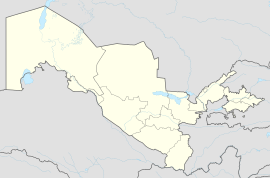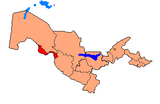Gurlan
Gurlan | |
|---|---|
Town | |
| Coordinates: 41°50′22″N 60°23′38″E / 41.83944°N 60.39389°E / 41.83944; 60.39389 | |
| Country | |
| Region | Xorazm Region |
| District | Gurlan District |
| Population (2016) | |
| • Total | 27,600 |
| Time zone | UTC+5 (UZT) |
Gurlan (Uzbek: Gurlan, Гурлан, گورلن; Russian: Гурлен, romanized: Gurlen) is a town and seat of Gurlan District in Xorazm Region in Uzbekistan.[1] It is located near the border with Turkmenistan in western Uzbekistan, 42 kilometres (26 mi) north-west of Urgench, north of Shovot, and south of the Amu Darya river. Gurlen is a major centre for cotton production, and rice and yams are also significant other crops.
History
Gurlen was one of the medieval cities of Khorezm. A fortress was built about 7 kilometres (4.3 mi) north of Gurlen called Taza Vazir ("New Vazir").[2] The Hanafi jurist of Khwarezm, Jalal ad-Din Kurlani, is from Gurlen.[3] In the early 19th century, it was a well-known merchant city of the Khanate of Khiva. Gurlen featured a New Method school from 1905 to 1911 which encountered extreme conservative opposition.[4] In the 1820s, it was a well-known merchant city of Khiva Khanate.[5] After the 1917 Russian Revolution the Khanate of Khiva was abolished, and Gurlen was eventually included into the Uzbek Soviet Socialist Republic. Bukhara, characterized as the nucleus of the Uzbek Soviet Socialist Republic, contained the part of Khorezm located within a triangle formed by Gurlen-Khiva-Pitniyak.[6] Gurlen was a part of Khorezm Oblast, which was abolished on September 29, 1926, and the center of Gurlen District. After 1926, Gurlen and the district were directly subordinated to the Uzbek Soviet Socialist Republic.[7] On October 1, 1938 Khorezm Oblast was re-established. It included Gurlen, which at the time had a status of rural locality, and Gurlen District.[8] It was classified as a rural locality until October 1981, when under Soviet rule it was granted urban-type settlement status.[9] In 1984, Gurlen was granted town status and became the town of oblast significance, meaning it was not a part of the district any more.[8] A children's hospital was built here during the Soviet period.[10] As Gurlen is located closer to Karakalpakistan, language there is a little bit different than in other towns in Khorezm.[citation needed]
Geography and climate
Gurlen is located in southern Uzbekistan, near the border with Turkmenistan. It is 42 kilometres (26 mi) north-west of Urgench, north of Shavat, and south of the Amu Darya river.[11] Nearby settlements include Ishandami to the southeast, Mangityap to the northwest, and Pakhtachi nearby to the west.[11] The Yangiabadskoe deposit, noted for rock in native slate which is used for brick manufacture, is situated 15 kilometres (9.3 mi) to the west of Gurlen.[12]
The climatic condition of the semi desertic region of Gurten is of extreme continental climate. [13] As the annual incidence of rainfall is more than the rate of evaporation, irrigation is an essential requirement for cultivation in this part of Uzbekistan.[13]
| Climate data for Gurlen, Uzbekistan | |||||||||||||
|---|---|---|---|---|---|---|---|---|---|---|---|---|---|
| Month | Jan | Feb | Mar | Apr | May | Jun | Jul | Aug | Sep | Oct | Nov | Dec | Year |
| Mean daily maximum °C (°F) | 2 (36) |
6 (43) |
13 (55) |
22 (72) |
28 (82) |
34 (93) |
35 (95) |
34 (93) |
28 (82) |
20 (68) |
11 (52) |
04 (39) |
35 (95) |
| Mean daily minimum °C (°F) | −7 (19) |
−4 (25) |
2 (36) |
9 (48) |
14 (57) |
19 (66) |
21 (70) |
18 (64) |
12 (54) |
5 (41) |
0 (32) |
−5 (23) |
−7 (19) |
| Average precipitation mm (inches) | 18.2 (0.72) |
11.3 (0.44) |
17.2 (0.68) |
13.7 (0.54) |
10.9 (0.43) |
8 (0.3) |
6.3 (0.25) |
13.5 (0.53) |
2 (0.1) |
4 (0.2) |
19.1 (0.75) |
12.7 (0.50) |
188.9 (7.44) |
| Source: Weatherbase [14] | |||||||||||||
Economy
Gurlen District is a major centre for cotton production (mainly for export) and the town is known for its cotton ginneries.[15][16] Other crops include rice, yams and wheat (introduced in 1990 for self-sufficiency in food), and when wheat is not grown during winter, other crops are grown such as maize, sorghum, water melons, melons, and vegetables.[13][17][18] The Uzbek government had stated that rice should not be grown in areas near the desert, but rice fields are apparent in the vicinity of Gurlen, and it forms the bulk of land use.[19] Irrigation in the area from damming the Amu Darya (Oxus River) which flows nearby, as part of the Amu Darya Irrigation System, has much improved agricultural production, and a number of Koreans were sent to farms in Gurlen during the Soviet era to convert the border desert areas of Kara Kum into fertile lands.[20]
Gurlen is a notable bread producer.[21] Gurlen has a shoe factory which is a Joint-Stock Company called the “Khorasm Poiafzali”, or Garlen Shoe Factory. It was established in 1988. Shoes are manufactured from raw materials, particularly leather. Transactions are carried out in English.[22] Several banks are located in the town centre including the Agro Bank, Xalq Bank and the Gurlen Milliy Bank.[23]
There is a large-scale poultry farm in Gurlan.[23]
Demographics
As of the 1989 Census, Gurlan had a population of 19,807.[24] Its population was 27,600 in 2016.[25] Uzbek is the state language, although the regional Kipchak Khorezm language is also spoken by some in Gurlen.[26][27] Residents are involved in professional trades of weaving, pottery, jewellery, baking, crafts and agricultural practices.[21]). Khiva is the major city centre close to this town. The garment worn by the people is known as Khivan dona, which is an outer garment, and the other garment of general use is Urgen chapan.[28] Musicians from the town are also well known in the country.[21]
References
- ^ "Classification system of territorial units of the Republic of Uzbekistan" (in Uzbek and Russian). The State Committee of the Republic of Uzbekistan on statistics. July 2020.
- ^ Khorezmiĭ, Munis; Ogaḣiĭ, Muḣammad Rizo Mirob Ėrniëzbek ŭghli (1999). Firdaws Al-iqbāl: History of Khorezm. BRILL. p. 565. ISBN 978-90-04-11365-7.
- ^ Renard, John (2009). Tales of God's Friends: Islamic Hagiography in Translation. University of California Press. pp. 135–. ISBN 978-0-520-25896-9. Retrieved 13 May 2013.
- ^ Allworth, Edward (1990). The Modern Uzbeks: From the Fourteenth Century to the Present : a Cultural History. Hoover Press. pp. 140–. ISBN 978-0-8179-8733-6. Retrieved 13 May 2013.
- ^ Путешествие в Туркмению и Хиву в 1819 и 1820 годах гвардейского генерального штаба капитана Николая Муравьева, посланного в сии страны для переговоров. М., 1822, с.32
- ^ Becker, Seymour (22 April 2004). Russia's Protectorates in Central Asia: Bukhara and Khiva, 1865-1924. Taylor & Francis. pp. 241–. ISBN 978-0-203-39083-2. Retrieved 13 May 2013.
- ^ Узбекская Советская Социалистическая Республика (in Russian). narod.ru. Retrieved 14 May 2013.[permanent dead link]
- ^ a b Хорезмский вилайет (in Russian). narod.ru. Retrieved 14 May 2013.[permanent dead link]
- ^ Soviet Geography. Scripta Publishing Company. 1985. p. 121.
- ^ Political History of Russia. Nova Science Publishers. 1995. p. 209.
- ^ a b Google (12 May 2013). "Gurlan" (Map). Google Maps. Google. Retrieved 12 May 2013.
- ^ IBP USA Staff (3 March 2008). Uzbekistan Mining Laws and Regulations Handbook. International Business Publications, USA. pp. 69–. ISBN 978-1-4330-7845-3. Retrieved 13 May 2013.
- ^ a b c "Spatio-temporal analyses of cropland degradation in the irrigated lowlands of Uzbekistan using remote-sensing and logistic regression modeling" (PDF). Journal of Environmental Monitoring and Assessment. Springer. 24 September 2012.
- ^ "Average High/Low Temperature for Gurlen, Uzbekistan". World Weather Online. Retrieved 13 May 2013. Retrieved on 13 May 2013
- ^ Martius, Christopher (September 2011). Cotton, Water, Salts and Soums: Economic and Ecological Restructuring in Khorezm, Uzbekistan. Springer. p. 338. ISBN 978-94-007-1963-7.
- ^ Э. Ю. Юсупов (1985). Тхе Остовер Револютион анд воменьс либератион ин Узбекистан. Наука Публишерс, Централ Депт. оф Ориенталь Литературе. p. 192. ISBN 9780828530903.
- ^ World Trade Centers Association (1998). World business directory. Gale Research Inc. p. 5262. ISBN 9780787613556.
- ^ Zoology in the Middle East. Max Kasparek. 2006. p. 51.
- ^ Erasmi, Stefan; Cyffka, Bernd; Kappas, Martin (2005). Remote Sensing & GIS for Environmental Studies: Applications in Geography. Erich Goltze. p. 122. ISBN 978-3-88452-113-7.
- ^ Olson, James S.; Pappas, Lee Brigance; Pappas, Nicholas Charles (1994). An Ethnohistorical dictionary of the Russian and Soviet empires. Greenwood Publishing Group. p. 393. ISBN 978-0-313-27497-8.
- ^ a b c J.A. Hammerton (1 January 2007). Peoples Of All Nations: Their Life Today And Story Of Their Past (in 14 Volumes). Concept Publishing Company. pp. 3234–. ISBN 978-81-7268-144-9.
- ^ BISNIS Search for Partners. Business Information Service for the Newly Independent States (BISNIS), U.S. Department of Commerce, International Trade Administration. 1997.[permanent dead link]
- ^ a b Гурлен - Справочник Узбекистана (in Russian). Золотые страницы Узбекистана. Retrieved 14 May 2013.
- ^ Demoscope Weekly (1989). "Всесоюзная перепись населения 1989 г. Численность городского населения союзных республик, их территориальных единиц, городских поселений и городских районов по полу" [All Union Population Census of 1989. Urban population of the union republics, their territorial units, urban settlements and urban districts by gender.]. Всесоюзная перепись населения 1989 года (All-Union Population Census of 1989) (in Russian). Institute of Demographics of the State University—Higher School of Economics. Retrieved May 16, 2013.
- ^ Soliyev, A.S. Shaharlar geografiyasi [Geography of cities] (PDF) (in Uzbek). p. 173.
- ^ Anita Sengupta (2003). The Formation of the Uzbek Nation-state: A Study in Transition. Lexington Books. pp. 292–. ISBN 978-0-7391-0618-1.
- ^ Radio Liberty Research Bulletin. Radio Free Europe/Radio Liberty. 1977.
- ^ Ahmad Hasan Dani; Chahryar Adle; Irfan Habib (2003). History of Civilizations of Central Asia: Development in Contrast, from the Sixteenth to the Mid-Nineteenth Century. UNESCO. pp. 69–. ISBN 978-92-3-103876-1.
41°51′N 60°24′E / 41.850°N 60.400°E / 41.850; 60.400

